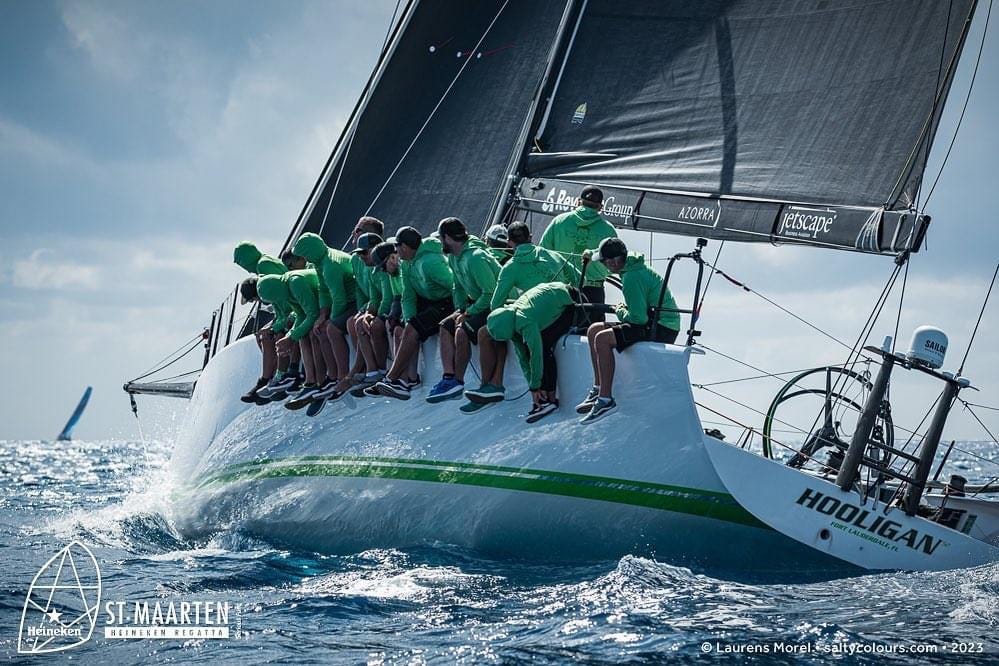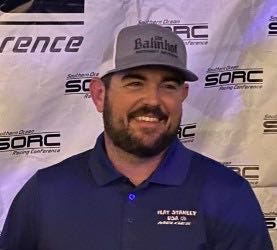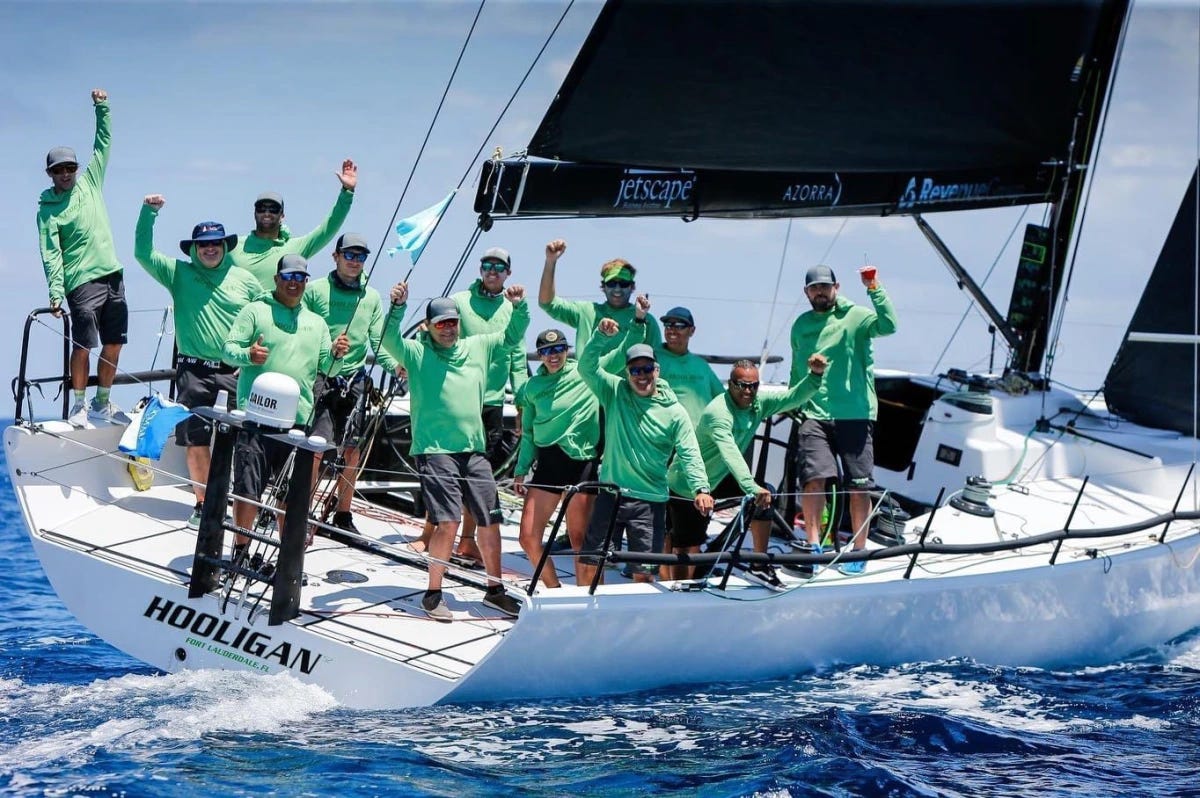Mackinac racer Nick Ward: What it takes to gain a competitive edge
As the navigator on Hooligan, he sleeps little or not at all and uses tech to harness wind speed and power
Nick Ward actually proves that the more you know, the faster you go.
And while he plays a critical role on the sailboat, he often doesn’t actually sail.
“To many people, a navigator position is kind of viewed like, ‘Don’t run aground. Go the right way. Tell me where the (race) mark’s at and how far away it is.’ I think the position is changing from that to … it’s very data driven and there’s tons of analytics,” Ward told Shifting Gears.
“I don’t do any sailing. My single job on the boat is navigation. I spend a lot of time below deck.”
Ward, 51, of Port Huron, Mich., an engineer who works remotely for Norma Group based near Frankfurt, Germany, translates his tech skill to sailboat racing on freshwater and saltwater.
On Saturday, Ward will sail the Port Huron to Mackinac Race on Hooligan, a TP52 owned/skippered by Trey Sheehan of Cleveland, Ohio, and John Evans of Fort Lauderdale, Fla., with 12 crew members from Michigan, Ohio, Florida, Massachusetts and South Carolina — plus sailors from Sarnia, Ontario, Canada (on the other side of the St. Clair River) and Oakville, near Toronto.
Ward won’t steer the boat or trim the sails to make them tighter or looser.
His job is to crunch information and feed it to the team.
Ward predicts what’s going to happen with weather and wind on the race course and which direction is the best direction to sail. Then the sailors must sail fast and effectively in the right direction.
May sound simple. Not simple.
Also, the navigator doesn’t take shifts. They’re on duty around the clock, until there’s a long period on the course that’s predictable. Ward said he (and others) likely would stay up the 20 hours or so he expected Hooligan to take to get to Mackinac.

On water, on ice
Much the way the Carolina Hurricanes hockey team hired a scientist named Eric Tulsky to use analytics to transform its game and win the Stanley Cup, this is the future of sailing. In the NHL, Tulsky looks at which conditions most likely lead to scoring — which players at what point in the game and under which circumstances — based on data.
For sailing, Ward spends days prior to a race just building weather models and race course models and assessing where the wind may be, based on temperatures and cloud formation.
“I used to rely on other people to give me weather data. Now I do my own weather analysis and compare it against what we’re sent. You can’t imagine how many YouTube videos I’ve watched about cloud heights, frontal weather and isobars” — lines on maps that show the atmosphere or air pressure at the surface of the earth.
Ward uses clouds to detect weather changes and can determine if the race boat is ahead or behind schedule for the model they’re using.
“You can see cloud sets have already come in, and that tells me to shift our planning,” he said.
Ward uses computer software to track weather 12 days before the race and starts running tests with data overlayed against the race course. Weather directly impacts wind, which impacts boat speed.
Weather forecasts also help determine which sails to choose for a race. That, alone, can mean victory or loss — before even setting sail.
As a navigator, he’s in charge of pre-race documentation, weather strategy, course strategy and equipment management. There’s more but we’ll get to that later.
Tim Prophit of St. Clair Shores, this year’s Mackinac race chairman, told Shifting Gears the navigator is a prestigious role that’s widely considered the brains of the operation.
He said he would sail with Ward “anytime, anyplace, any boat.”
In 2011, Ward sailed with Prophit on his boat Fast Tango, a North American 40, in the Chicago to Mackinac Race. They won first in class and first overall despite 100-knot winds (115 mph) that left two sailors from Saginaw, Mich., dead when their boat WingNuts, a Kiwi 35 with a crew of eight, capsized in Lake Michigan.
Prophit, past commodore of the Bayview Yacht Club in Detroit, at the time compared the experience of that 289 nautical mile race as “standing in the direct wash of a jet engine.” Sail-World magazine described the storm-plagued event as a “tale of horror.”
Ward has won his class two more times sailing the Chicago race course, on Equation (an Andrews 68) and Fine Line (a Nelson Marek 46). He won his class sailing from Port Huron on Station Wagon (an SR 33).
“All the Macs are one big blur,” he said.
Rules: You don’t know everything
A lot of racing is about preparation, which means understanding all rules, sailing instructions, safety requirements and the boat rating system. Much like golf, sailing has a rating system that handicaps each boat to make the race fair. When a boat finishes a race, it has an actual time and corrected time. Corrected time reflects the rating that considers things such as boat weight, boat design, sail size choices and total crew weight.
“I make sure I understand all the rules well enough that I can be asked a question during a race and not have to go to a document for clarification, to make sure we’re racing the course correctly and efficiently,” Ward said.
There are rules for the restart, mid-race and after race.
“For example, when (headed to Mackinac), you round Cove Island, it’s a virtual mark. So you need to understand where it’s at, exactly, and make sure you take a photo. Then you log the photo and distribute it (to race officials) correctly,” Ward said. “That would be something people forget time and again.”
Turning in a finish card on time after the Mackinac Race is something people sometimes don’t do, so they get penalty points assessed after they’ve finished a competitive race, Ward noted.
“They go through a whole race and they get up there and somebody loses the card and they decide, ‘hey, we made it. Let’s go have fun,’” Ward said. “Having fun is the point of sailing. But I make sure small things get done so we don’t get unwanted time added to our race because of something simple.”
In distance racing, it’s important to know details that include which events automatically assess a penalty when a boat crosses the starting line early — so there’s no need to go back and restart.
“Sailing instructions are pages and pages long,” Ward said. “I think people get into this habit, when they’ve done a race 25 or 30 times, that they know how to get there. They think they don’t need to go back and read the rules. But there are always small changes.”
Even pre-race safety inspections are a big deal, like having enough people on the boat with safety-at-sea training that teaches effective man overboard maneuvers and understanding critical weather issues. Not meeting requirements means penalties. Small oversights turn into big headaches.
A non-sailor has no idea the level of preparation involved. People think these men and women hop on boats, hoist sails, capture the wind and go. Notsomuch.
Clouds: Beware of large, dark, puffy balls
Navigators on race boats must understand clouds, Ward said.
While more than 100 different types of clouds exist, they can be grouped into 10 categories based on shape and height. Knowing weather patterns is essential.
“I’m spending an hour or two a day reviewing weather forecast data,” Ward said. “I’m running race routes against the forecast data to understand our sail selections that we’re going to use for what’s going to be most prevalent wind conditions. What angles are we going to sail? What angles are going to be the best for us? Then we’ll go out (this week) and we’ll practice all those angles.”

The crew of Hooligan will make sure everything they practice is aligned with how they think the race is going to go to maximize speed and efficiency.
“I don’t know if anybody else does this but I actually build a pre-race presentation,” Ward said. “I work in the automotive industry. I write lots of presentations. I found it’s been very helpful to do it for this group too.”
So he'll write a 25- to 30-page presentation about the race that’ll include data involving the starting line location and time, which boats will be racing in the same class, how much time each competitor boat will be owed based on rating. Ward will invite his team to a strategy party at his house on Friday night, the eve of the race.
For this 101st Bayview Mackinac Race, 195 boats were registered as of Wednesday — sailing the Shore Course (204 nautical miles) and the Cove Island Course (259 nautical miles).
“Here, the sun twilights after 10 and you get morning light at 5:45. So it’s really only dark for about seven hours,” Ward said. “When you sail in Florida or go to the Caribbean in February, the sun goes down at 5 and doesn’t come up until 8. So it’s dark for 14 hours. That’s a completely different environment. Sailing in the winter is in the dark.”
Electronics: You are the IT guy (ugh)
It was sailmaker Brad Boston of Sarnia, Ontario, Canada, who also races on Hooligan, who initially suggested to Ward that he get into navigation because of his tech know-how.
“A big portion of what I do is manage all the electronics on the boat,” Ward said. “It’s my responsibility to make sure they work, make sure they’re calibrated and if any additions or subtractions to anything in the software or hardware is needed, it’s my responsibility to fix.”
Originally, it all started out with a tablet, basically an iPad, Ward said. He made sure the boat was always going the right way and not running aground — which, incredibly, isn’t always the case in Mackinac races.
But Ward goes further. He makes diagrams to determine how the boat is going to perform at different wind angles and wind speed. His systems can say how fast the boat should be going all the time with every wind condition, and if it’s performing at peak level.
“Sail trimmers use that data” to adjust sails, Ward said.
Sail charts are essential to determine which sails are best to take.

Hooligan, for example, has more than a dozen sails and Ward can say which sail is best for which wind speed and angle. Approaching marks on the race course, the crew has information it needs to make sail changes with real time updates.
“This allows us to be really efficient,” Ward said. “I can say our true wind angle is going to change to 75 degrees, so let’s get prepared. Everybody starts to work to get the boat ready, when we come around the mark, there you go.”
He tracks the speed and location of all boats in the area of Hooligan, updating the YellowBrick tracking technology every 15 minutes to monitor wind patterns all over the course.
Current isn’t a huge factor in the Great Lakes, Ward said. When sailing on the ocean, finding the current is important so a navigator tracks water temperature — the higher the temperature, the more current in the Gulf Stream that brings warm water from what has been known as the Gulf of Mexico into the Atlantic Ocean. (Note: U.S. government websites use the term Gulf of America. now.)
Sensitive topic: ‘An item you can control’
After entering race competitions, a boat gets a rating and many teams work to adjust that racing — in areas such as the declared crew weight.
“That’s an item you can control,” Ward said. “Some races we might sail with 14 and another we sail with 12.”
He also works with sailmakers to run analytics on the impact of a new sail and how certain sail sizes might effect performance under specific conditions. “I’ll break it into a formula that tells them this sail will cost us this much per hour, per six hours, per day in comparison to where we were before. I’ll break down the effect on our competition in our class and whether there’s a rating benefit.”

Personal twist
When Shifting Gears asked sailors at various clubs for a short list of navigators, Ward’s name popped up repeatedly. Yet he only started competing at age 24.
He has won best navigator three times after racing on the Atlantic Ocean from Fort Lauderdale to Key West, Fla., and twice after the Mills Trophy Race, a challenging course from the Toledo Harbor Light, around the Lake Erie islands, to Put-in-Bay, Ohio, at night.
Why sailing: “When I was a kid, I used to go sailing with my grandfather, just a few times in the summer on Lake Huron,” said Ward, who played football and threw hammer, discus and shot put at Hope College in Holland, Mich. “My friend C.J. Ruffing had a boat and invited me to start sailing between Detroit and Port Huron.”
Boat conduct: Yelling is “super unhelpful” and Ward avoids sailing with people who yell. “If I raise my voice, it’s because you can’t hear me or I’m excited, not because I’m upset.” When people yell, other people don’t want to contribute, he said. “It stops information flow. If people feel anytime they contribute that they’ll make a mistake, they’ll just retract from everything. You can’t make a mistake if you don’t do anything.”
Bare bones sailing: On Proper Villain, a T10 sailboat that Ward co-owns, he uses no electronics or wind gauge or chart plotters— just a compass and speed. “It’s bare bones. My partner, Greg Kinney, he’s the helmsman and I call tactics and trim the main (sail).”
What’s next: Hooligan is racing the Ultra Mac, which means it will sail from Port Huron to Mackinac Island, through the finish line, then continue racing to Chicago — 548 nautical miles total. Then Hooligan will turn around and race on July 19 from Chicago to Mackinac.
“I’m either working or sailing,” Ward said, laughing. “That’s all I do.”
Phoebe Wall Howard, a Grosse Pointe native, covered sailing for The Detroit Free Press for seven years, until 2024. Find her recent sailing stories here.
As Tomahawk sank, T.K. Lowry said he couldn’t fit into the life raft
Champion Sailer: Yelling never made anyone faster or better
World champion who races Mackinac: Mistakes to avoid
Note: I’m a proud member of the Iowa Writers’ Collaborative. Please check out a great mix of political analysis, features and news from the Heartland here




Fascinating, Phoebe. Loved the bit about the puffy, dark clouds! Metaphor for life.